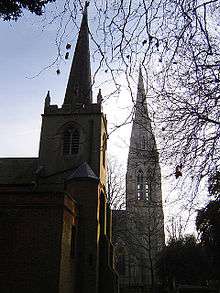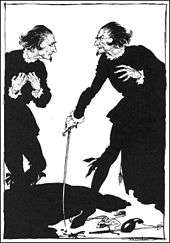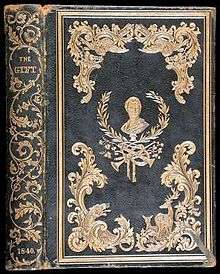William Wilson (short story)
| "William Wilson" | |
|---|---|
|
The Gift, Carey and Hart, Philadelphia, 1840 | |
| Author | Edgar Allan Poe |
| Country | United States |
| Language | English |
| Genre(s) | Short story |
| Published in | Burton's Gentleman's Magazine |
| Media type | Monthly magazine |
| Publication date | October 1839 |
"William Wilson" is a short story by Edgar Allan Poe, first published in 1839, with a setting inspired by Poe's formative years on the outskirts of London. The tale follows the theme of the doppelgänger and is written in a style based on rationality. It also appeared in the 1840 collection Tales of the Grotesque and Arabesque, and has been adapted several times.
Plot summary
The story follows a man of "a noble descent" who calls himself William Wilson because, although denouncing his profligate past, he does not accept full blamefor his actions, saying that "man was never thus [...] tempted before". After several paragraphs, the narration then segues into a description of Wilson's boyhood, which was spent in a school "in a misty-looking village of England".
William meets another boy in his school who shared the same name, who had roughly the same appearance, and who was even born on exactly the same date (January 19, Poe's own birthday). William's name (he asserts that his actual name is only similar to "William Wilson") embarrasses him because it sounds "plebeian" or common, and he is irked that he must hear the name twice as much on account of the other William.
The boy also dresses like William, walks like him, but he could only speak in a whisper, he imitates that whisper exactly. He begins to give advice to William of an unspecified nature, which he refuses to obey, resenting the boy's "arrogance". One night he steals into the other William's bedroom and recoils in horror at the boy's face-which now resembles his own. William then immediately leaves the academy, and in the same week, the other boy follows suit.
William eventually attends Eton and Oxford, gradually becoming more debauched and performing what he terms "mischief". For example, he steals from a man by cheating at cards. The other William appears, his face covered, whispers a few words sufficient to alert others to William's behavior, and then leaves with no others seeing his face. William is haunted by his double in subsequent years, who thwarts plans described by William as driven by ambition, anger, and lust. In his latest caper, he attempts to seduce a married woman at Carnival in Rome, but the other William stops him; the enraged protagonist drags his "unresisting" double —who wears identical clothes— into an antechamber, and stabs him fatally.
After William does this, a large mirror suddenly seems to appear. Reflected at him, he sees "mine own image, but with features all pale and dabbled in blood": apparently the dead double, "but he spoke no longer in a whisper". The narrator feels as if he is pronouncing the words: "In me didst thou exist—and in my death, see [...] how utterly thou hast murdered thyself."
Background

The setting of "William Wilson" is semi-autobiographical and relates to Poe's residence in England as a boy. The "misty-looking village of England" of the story is Stoke Newington, now a suburb of north London. The school is based on the Manor House School in Stoke Newington which Poe attended from 1817 to 1820. Poe's headmaster there, the Reverend John Bransby, shares the same name as the headmaster in the story, though, in the latter, he acquires the dignity of being a "Doctor".[1] This school has since been demolished. The church mentioned in the story is based on St Mary's "Old" Church, the original parish church of Stoke Newington. This building is still extant. Interestingly, in Poe's story the church is described to have a Gothic spire. The spire, however, was only added to the real church in 1829 some nine years after Poe had quit the school, and indeed London.
Additionally, Poe acknowledged that the idea of a story about the irritation one feels by meeting someone with the same name, thereby ruining a feeling of uniqueness, was inspired by Washington Irving's "An Unwritten Drama of Lord Byron". At the end of Irving's tale, the main character kills his double with his sword, only to see his own face behind the mask.[2]
Analysis
"William Wilson" clearly explores the theme of the double. This second self haunts the protagonist and leads him to insanity and also represents his own insanity.[3] According to Poe biographer, Arthur Hobson Quinn, the second self represents the conscience.[4] This division of the self is reinforced by the narrator's admission that "William Wilson" is actually a pseudonym. The name itself is an interesting choice: "son" of "will". In other words, William Wilson has willed himself into being along with the double which shares that name.[5]
Poe wrote the story very carefully and with subtlety. Sentences are balanced, with very few adjectives, and there is little concrete imagery beyond the description of Wilson's school. Pacing is purposely set as leisurely and measured using a formal style and longer sentences. Rather than creating a poetic effect or mood, as Poe recommends in "The Philosophy of Composition", Poe is creating a tale based on rationality and logic.[6]
Publication history
"William Wilson" was published in the October 1839 issue of Burton's Gentleman's Magazine, though it appeared earlier that year in The Gift: A Christmas and New Year's Present dated for 1840.[7] The tale was later translated into French in December 1844, printed in the Paris newspaper La Quotidienne in two installments. This was the first translation of Poe's work to a language other than English and marked Poe's introduction to France.[8]
Critical reception

When Poe wrote to Washington Irving asking for a word of endorsement, he specifically requested a response to "William Wilson", calling it "my best effort".[9] Irving responded, "It is managed in a highly picturesque Style and the Singular and Mysterious interest is well sustained throughout".[10] Thomas Mann said of Fyodor Dostoevsky's The Double: A Petersburg Poem, which explores a similar doppelgänger theme, "by no means improved on Edgar Allan Poe's 'William Wilson,' a tale that deals with the same old romantic motif in a way far more profound on the moral side and more successfully resolving the critical [theme] in the poetic".[3]
Adaptations
In 1913, "William Wilson" was freely adapted into The Student of Prague, a German film directed by Stellan Rye and Paul Wegener and starring Wegener. A 1926 version was also made in Germany and directed by Henrik Galeen and starred Conrad Veidt. A third German adaptation, made in 1935, was directed by Arthur Robison and starred Anton Walbrook.
In 1943, "William Wilson" was adapted as a radio play for The Weird Circle on the Mutual Broadcasting System.[11]
A French-Italian collaboration came out in 1968 called Spirits of the Dead or Histoires extraordinaires. The film is composed of three vignettes, directed by Roger Vadim, Louis Malle and Federico Fellini and starring Alain Delon and Brigitte Bardot.[12] The other two segments adapt Poe's "Metzengerstein" and "Never Bet the Devil Your Head". It would also form the basis for The Smithereens' song of the same name, from their 1989 album "11".
There are strains of the story of "William Wilson" in Andrew Taylor's "The American Boy", in which Edgar Allan Poe himself is featured as a character.
In 1968, Editora Taika in Brazil published a comic adaptation in Album Classicos De Terror #6. Art was by Osvaldo Talo. It was reprinted in Classicos De Terror (2nd series) #5 in June 1973.
In 1974, Skywald published a comic adaptation in Nightmare #19 (June 1974), adapted by Al Hewetson, with art by Alfonso Font. This was reprinted by Mehmet K. Benli Turkey in Vampirella #3 (October 25, 1976) and Vampirella # (1977); and by Eternity Comics in Edgar Allan Poe: The Tell-Tale Heart and Other Stories #1 (June 1988).
In 1979, Ediciones De La Urraca in Argentina published a comic adaptation in El Pendulo #2 (October 1979). Adaptation was by Guillermo Saccomanno, art was by Alberto Breccia. This was reprinted by Les Humanoides Associes in France in Le Coeur Revelator (1992 and September 1995) and by Doedyeeditores in Argentina in El Gato Negro Y Outras Historias (2011).
In 1979, Bloch Editores S.A. in Brazil published a comic adaptation in Aventuras Macabras #12 (1979). The adaptation and art were by Jose Menezes.
In 1999, Spanish director Jorge Dayas released a 35 mm animated short film, awarded in Animadrid 2000 and Malaga Film Festival.[13]
References
- ↑ Quinn, Arthur Hobson Quinn. Edgar Allan Poe: A Critical Biography. Baltimore: The Johns Hopkins University Press, 1998: 75.
- ↑ Silverman, Kenneth. Edgar A. Poe: Mournful and Never-ending Remembrance. New York City: Harper Perennial, 1991: 149–150. ISBN 0-06-092331-8
- 1 2 Meyers, Jeffrey. Edgar Allan Poe: His Life and Legacy. New York: Cooper Square Press, 1992: 287. ISBN 0-8154-1038-7
- ↑ Quinn, Arthur Hobson Quinn. Edgar Allan Poe: A Critical Biography. Baltimore: The Johns Hopkins University Press, 1998: 286–287.
- ↑ Hoffman, Daniel. Poe Poe Poe Poe Poe Poe Poe. Baton Rouge: Louisiana State University Press, 1972. p. 209. ISBN 0-8071-2321-8
- ↑ Stauffer, Donald Barlow. "Style and Meaning in 'Ligeia' and 'William Wilson'", from Twentieth Century Interpretations of Poe's Tales, edited by William L. Howarth. Englewood Cliffs, NJ: Prentice-Hall Inc., 1971: 82.
- ↑ Sova, Dawn B. Edgar Allan Poe: A to Z. New York: Checkmark Books, 2001: 256. ISBN 0-8160-4161-X
- ↑ Silverman, Kenneth. Edgar A. Poe: Mournful and Never-ending Remembrance. New York City: Harper Perennial, 1991: 233. ISBN 0-06-092331-8
- ↑ Neimeyer, Mark. "Poe and Popular Culture", collected in The Cambridge Companion to Edgar Allan Poe. Cambridge University Press, 2002: 207. ISBN 0-521-79727-6
- ↑ Jones, Brian Jay. Washington Irving: An American Original. New York: Arcade Publishing, 2008: 334. ISBN 978-1-55970-836-4
- ↑ Jerry Haendiges Vintage Radio Logs: The Weird Circle
- ↑ Sova, Dawn B. Edgar Allan Poe: A to Z. New York City: Checkmark Books, 2001: 256–257. ISBN 0-8160-4161-X
- ↑ "William Wilson". Internet Movie DataBase.
External links
 The full text of William Wilson at Wikisource
The full text of William Wilson at Wikisource Media related to William Wilson (Poe) at Wikimedia Commons
Media related to William Wilson (Poe) at Wikimedia Commons- "William Wilson" with annotated vocabulary at PoeStories.com
- "William Wilson", an avant-garde film directed by Michael Van Devere. 2011.
-
 William Wilson public domain audiobook at LibriVox
William Wilson public domain audiobook at LibriVox
